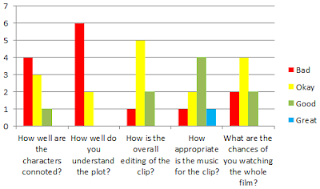Through our knowledge of the uses and gratifications theory, we were able to successfully appeal to and entice our target audiences. As the theory states that consumers of the media are active, and will choose media which satisfies their needs, we were able to tailor our film opening to suit these particular needs for:
-entertainment & escapism
-information
-personal identity
-social interaction
Below is a mind-map of how we used this theory to address the audience...
(please use the mouse to navigate, + to zoom in and - to zoom out)
Use of conventions & audience expectations:
As well as the uses and gratifications theory, we also directly targeted our niche audience of psychological thriller fans using conventional characters, shots and action, as well as genre codes in order to maintain plausibility and meet the expectations of this audience. For example:
-The use of props (moodboard, camera, gloves, etc.) - in particular the knife - created a sense of unease and clearly indicated the thriller genre & darker elements within the storyline.
-Our use of framing for effect within the sequence: low-angle shots create a sense of power around the antagonist, whilst OTS shots and eyeline matches add perspective and immerses the viewer in the story.
-Use of pulsing music and cold grading are also commonly found in psychological thriller films.
 |
| An example of Grace's aggression |
-Moreover, our use of continuity techniques (match-on action, eyeline matches, etc.) increased the realism our film was able to convey.
Meanwhile, we also used Barthes' enigma theory throughout (see Evaluation Q1), leaving questions from the audience unanswered to keep the viewer interested and watching to have these questions answered.
Audience feedback:
Throughout the project - especially during the production stage, we collected crucial feedback from a sample group of 8 people from our main target audience between 15 & 24 in order to track whether our vision was being translated into a decent finished article. To ensure the data was fair, the genders were mixed and the ages of the group varied. This feedback was of course extremely important and benefited us hugely, as it offered an insight into our work from the viewer's point of view.
-the rough cut
-the final edit
Below are the results of the feedback after the rough edit:
 |
| Rough edit feedback results |
The initial comments after the test shoot were, admittedly, pretty abysmal:
-The setting was too tight & this limited shot variation.
-The characterisation was poor: unclear who the characters were: we didn't use our main actress & didn't have any nailed-down hair/make-up & costume decisions
-The storyline & plot were completely lost, with weird sounds (e.g heavy breathing) confusing the audience.
However, in hindsight these comments were pivotal in helping us edit our storyline and in turning our project around - as is evident from the contrast in feedback between the initial rough cut and the final production. I also conducted some extra individual reactions from the audience which you can access by clicking the sheets & video below...
 |
| Final edit feedback results |
 |
| (please click to enlarge) Further audience feedback which I conducted after the final outcome |
Audience feedback video


No comments:
Post a Comment